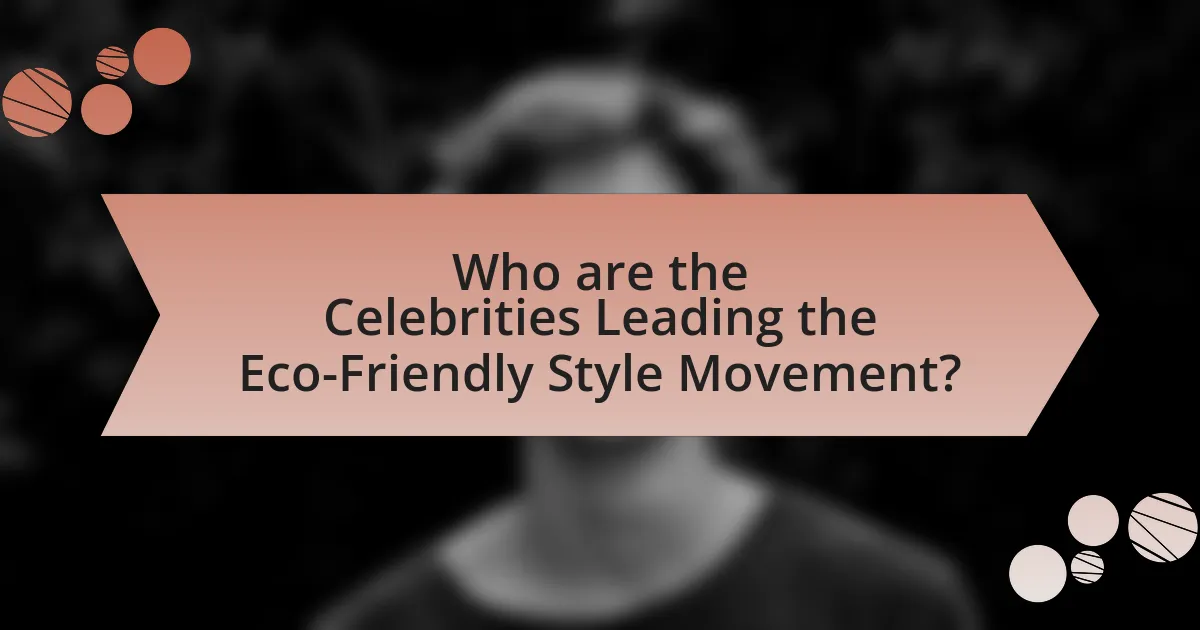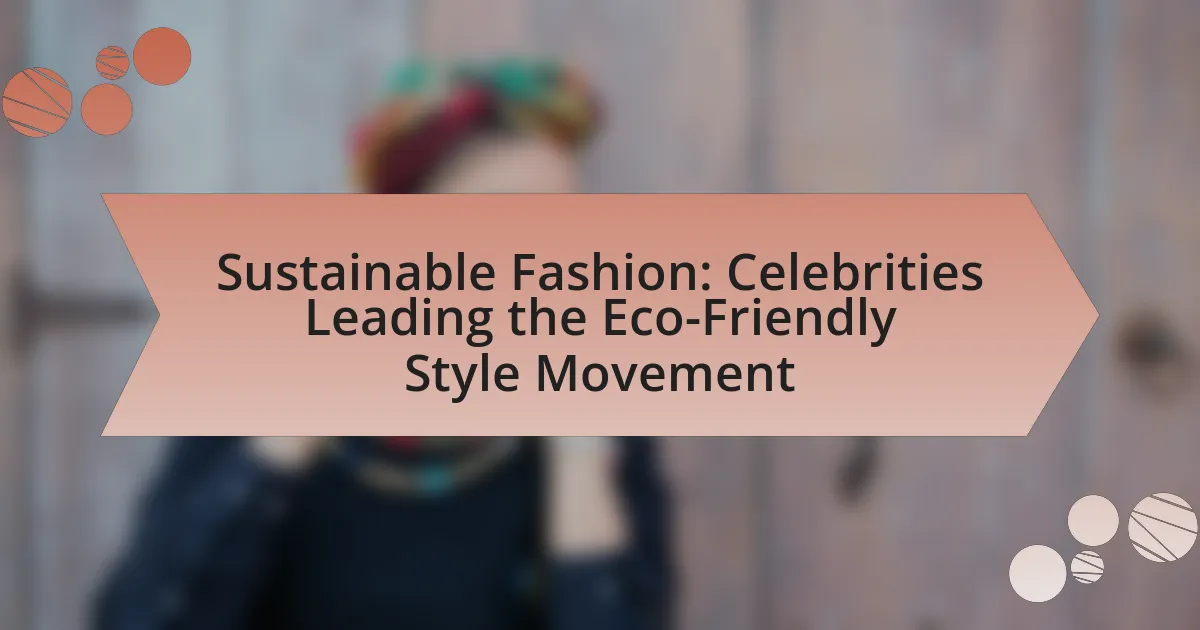Sustainable fashion is defined as clothing and accessories produced with minimal environmental impact and a focus on social responsibility. The article explores the significant differences between sustainable fashion and fast fashion, highlighting the environmental degradation caused by the latter, which accounts for 10% of global carbon emissions and substantial textile waste. It discusses the core principles of sustainable fashion, including ethical production and resource conservation, and emphasizes the role of celebrities like Emma Watson and Leonardo DiCaprio in promoting eco-friendly practices. Additionally, the article outlines practical steps consumers can take to embrace sustainable fashion, such as supporting eco-friendly brands, shopping second-hand, and utilizing social media to advocate for sustainability.

What is Sustainable Fashion and Why is it Important?
Sustainable fashion refers to clothing and accessories that are designed, produced, and consumed in a way that minimizes environmental impact and promotes social responsibility. This approach is important because the fashion industry is one of the largest polluters globally, contributing to significant waste, water usage, and carbon emissions. For instance, the Ellen MacArthur Foundation reports that the fashion industry is responsible for 10% of global carbon emissions and consumes around 93 billion cubic meters of water annually. By adopting sustainable practices, the industry can reduce its ecological footprint, support ethical labor practices, and encourage consumers to make more conscious choices, ultimately fostering a healthier planet and society.
How does Sustainable Fashion differ from Fast Fashion?
Sustainable fashion prioritizes environmentally friendly practices and ethical labor standards, while fast fashion focuses on rapid production and low-cost garments. Sustainable fashion aims to minimize waste, use eco-friendly materials, and ensure fair labor conditions, often resulting in higher quality and longer-lasting products. In contrast, fast fashion relies on quick turnaround times, mass production, and often exploitative labor practices to deliver trendy items at low prices, contributing to significant environmental degradation and social issues. For instance, the fast fashion industry is responsible for 10% of global carbon emissions, highlighting its detrimental impact compared to the more responsible approach of sustainable fashion.
What are the environmental impacts of Fast Fashion?
Fast fashion significantly harms the environment through excessive resource consumption, pollution, and waste generation. The industry is responsible for approximately 10% of global carbon emissions, primarily due to the production processes that rely heavily on fossil fuels. Additionally, fast fashion contributes to water pollution, with textile dyeing releasing toxic chemicals into waterways, affecting aquatic ecosystems and human health. The production of garments also consumes vast amounts of water; for instance, producing a single cotton t-shirt requires about 2,700 liters of water, which exacerbates water scarcity issues in many regions. Furthermore, fast fashion generates enormous amounts of textile waste, with an estimated 92 million tons of textiles discarded annually, leading to overflowing landfills and increased greenhouse gas emissions as these materials decompose.
How does Sustainable Fashion address these impacts?
Sustainable fashion addresses environmental and social impacts by promoting eco-friendly materials, ethical labor practices, and reduced waste. By utilizing organic fabrics, recycled materials, and sustainable production methods, sustainable fashion significantly lowers carbon emissions and resource consumption. For instance, the use of organic cotton reduces pesticide use by 90% compared to conventional cotton farming, thus minimizing environmental harm. Additionally, brands committed to sustainable fashion often ensure fair wages and safe working conditions for their workers, addressing social inequalities in the fashion industry. This holistic approach not only mitigates negative impacts but also fosters a more responsible and conscious consumer culture.
What are the core principles of Sustainable Fashion?
The core principles of Sustainable Fashion include ethical production, resource conservation, and social responsibility. Ethical production emphasizes fair labor practices and transparency in the supply chain, ensuring that workers are treated fairly and paid adequately. Resource conservation focuses on minimizing waste and using sustainable materials, such as organic cotton or recycled fabrics, to reduce environmental impact. Social responsibility involves promoting inclusivity and supporting local communities, which can enhance the overall well-being of society. These principles collectively aim to create a fashion industry that is environmentally friendly, socially equitable, and economically viable.
How do ethical labor practices play a role in Sustainable Fashion?
Ethical labor practices are essential to sustainable fashion as they ensure fair treatment, safe working conditions, and equitable wages for workers in the fashion industry. These practices contribute to sustainability by promoting social responsibility and reducing exploitation, which aligns with the broader goals of environmental and social sustainability. For instance, brands that adopt ethical labor practices often see increased consumer trust and loyalty, as evidenced by a 2021 survey indicating that 66% of consumers are willing to pay more for sustainable products. This shift not only supports workers but also encourages a more sustainable supply chain, ultimately fostering a fashion industry that prioritizes both people and the planet.
What materials are considered sustainable in fashion?
Sustainable materials in fashion include organic cotton, Tencel, hemp, recycled polyester, and linen. Organic cotton is grown without synthetic pesticides or fertilizers, reducing environmental impact. Tencel, made from sustainably sourced wood pulp, is biodegradable and produced in a closed-loop process that recycles water and solvents. Hemp requires minimal water and no pesticides, making it a low-impact crop. Recycled polyester, derived from post-consumer plastic bottles, helps reduce waste and energy consumption compared to virgin polyester. Linen, made from flax plants, is biodegradable and requires less water than cotton. These materials contribute to a more sustainable fashion industry by minimizing resource use and environmental harm.

Who are the Celebrities Leading the Eco-Friendly Style Movement?
Celebrities leading the eco-friendly style movement include Emma Watson, Leonardo DiCaprio, and Stella McCartney. Emma Watson advocates for sustainable fashion through her work with the UN and her commitment to wearing eco-conscious brands. Leonardo DiCaprio promotes environmental awareness and sustainable practices through his foundation, which supports various eco-friendly initiatives. Stella McCartney, a designer known for her commitment to cruelty-free and sustainable fashion, has been a pioneer in the industry, using organic materials and promoting ethical production methods. These celebrities significantly influence public awareness and acceptance of sustainable fashion practices.
Which celebrities are most recognized for their sustainable fashion choices?
Celebrities most recognized for their sustainable fashion choices include Emma Watson, Stella McCartney, and Leonardo DiCaprio. Emma Watson advocates for sustainable fashion through her work with the Green Carpet Challenge and her role as a UN Women Goodwill Ambassador, promoting ethical brands. Stella McCartney, a pioneer in sustainable luxury fashion, has built her brand on eco-friendly practices and materials. Leonardo DiCaprio, known for his environmental activism, supports sustainable fashion initiatives and has invested in eco-conscious brands. These celebrities exemplify the integration of sustainability into the fashion industry, influencing public awareness and consumer behavior.
What brands do these celebrities endorse or create?
Celebrities in the sustainable fashion movement endorse or create brands such as Stella McCartney, who is known for her eco-friendly luxury fashion line, and Emma Watson, who has collaborated with brands like People Tree to promote ethical clothing. Additionally, Leonardo DiCaprio supports sustainable brands like Rothy’s, which focuses on recycled materials, while Gigi Hadid has worked with Reebok on sustainable footwear. These endorsements and creations highlight their commitment to eco-friendly practices in the fashion industry.
How do these celebrities influence public perception of Sustainable Fashion?
Celebrities influence public perception of sustainable fashion by leveraging their platforms to promote eco-friendly brands and practices. Their visibility and popularity can significantly shape consumer attitudes, making sustainable choices more appealing. For instance, when celebrities like Emma Watson advocate for sustainable fashion, they draw attention to ethical brands, encouraging fans to consider the environmental impact of their purchases. Research indicates that celebrity endorsements can increase consumer interest in sustainable products by up to 50%, demonstrating their powerful role in shifting public perception towards eco-consciousness.
What initiatives have celebrities launched to promote Sustainable Fashion?
Celebrities have launched various initiatives to promote sustainable fashion, including collaborations with eco-friendly brands and the establishment of their own sustainable clothing lines. For instance, Stella McCartney, a prominent advocate for sustainable fashion, has created a luxury brand that emphasizes the use of organic materials and ethical production practices. Additionally, Emma Watson has partnered with the Green Carpet Challenge to promote sustainable fashion choices on red carpets, encouraging designers to use eco-friendly materials. Furthermore, Leonardo DiCaprio has supported initiatives like the “Fashion for Good” program, which aims to innovate sustainable practices in the fashion industry. These initiatives demonstrate a growing commitment among celebrities to influence the fashion industry towards more sustainable practices.
How effective are these initiatives in raising awareness?
These initiatives are highly effective in raising awareness about sustainable fashion. Research indicates that celebrity endorsements significantly increase public interest and engagement in eco-friendly practices, with a study by the University of Southern California showing that social media campaigns featuring celebrities can boost awareness by up to 70%. Additionally, initiatives led by well-known figures often result in increased media coverage, further amplifying the message and reaching broader audiences. This combination of celebrity influence and media attention creates a powerful platform for promoting sustainable fashion practices.

How Can Consumers Embrace Sustainable Fashion Inspired by Celebrities?
Consumers can embrace sustainable fashion inspired by celebrities by following their lead in choosing eco-friendly brands and advocating for ethical practices. Many celebrities, such as Emma Watson and Leonardo DiCaprio, actively promote sustainable fashion through their public appearances and social media platforms, showcasing brands that prioritize environmental responsibility. For instance, Emma Watson has collaborated with sustainable fashion initiatives like the Green Carpet Challenge, which encourages designers to create eco-conscious collections. By supporting these brands and initiatives, consumers can contribute to a growing movement that values sustainability in the fashion industry.
What practical steps can consumers take to adopt Sustainable Fashion?
Consumers can adopt sustainable fashion by prioritizing second-hand shopping, choosing eco-friendly brands, and practicing mindful consumption. Second-hand shopping reduces waste and extends the life cycle of clothing, as evidenced by the growing popularity of thrift stores and online resale platforms, which have seen a 25% increase in sales over the past five years. Selecting eco-friendly brands that utilize sustainable materials and ethical production practices supports environmentally responsible businesses; for instance, brands like Patagonia and Reformation are known for their commitment to sustainability. Additionally, practicing mindful consumption by buying only what is necessary and caring for garments to prolong their use helps minimize environmental impact, as studies show that extending the life of clothing by just nine months can reduce carbon, water, and waste footprints by 20-30%.
How can consumers identify sustainable brands?
Consumers can identify sustainable brands by looking for certifications such as Fair Trade, Global Organic Textile Standard (GOTS), and the Better Cotton Initiative (BCI). These certifications indicate that brands adhere to specific environmental and social standards. Additionally, consumers should examine a brand’s transparency regarding its supply chain, materials used, and production processes. Brands that openly share information about their sourcing, labor practices, and environmental impact are more likely to be sustainable. Research shows that 66% of consumers are willing to pay more for sustainable brands, highlighting the growing demand for transparency and ethical practices in the fashion industry.
What are the benefits of shopping second-hand or vintage clothing?
Shopping second-hand or vintage clothing offers several benefits, primarily environmental sustainability, cost savings, and unique fashion choices. By purchasing pre-owned garments, consumers help reduce textile waste, as the fashion industry is responsible for 92 million tons of waste annually, according to the United Nations. Additionally, second-hand clothing is often more affordable than new items, allowing shoppers to save money while still acquiring quality pieces. Furthermore, vintage clothing provides a distinctive style that sets individuals apart from mainstream fashion trends, promoting personal expression and creativity.
What role does social media play in promoting Sustainable Fashion?
Social media plays a crucial role in promoting sustainable fashion by providing a platform for brands, influencers, and consumers to share information and advocate for eco-friendly practices. Through visual storytelling and engagement, social media enables sustainable fashion brands to reach wider audiences, showcasing their ethical production processes and environmentally friendly materials. For instance, platforms like Instagram and TikTok allow influencers to demonstrate sustainable fashion choices, which can lead to increased consumer awareness and demand for eco-conscious products. Research indicates that 79% of consumers are influenced by social media when making purchasing decisions, highlighting its effectiveness in shaping consumer behavior towards sustainability.
How can consumers use social media to support eco-friendly brands?
Consumers can use social media to support eco-friendly brands by actively sharing and promoting their products, values, and initiatives. By posting about eco-friendly brands, consumers can increase visibility and awareness, encouraging their followers to consider sustainable options. Research indicates that 79% of consumers are influenced by social media when making purchasing decisions, highlighting the power of online platforms in shaping consumer behavior. Additionally, engaging with brands through comments, likes, and shares can foster community support and amplify the message of sustainability, further driving interest and sales for eco-friendly products.
